Gateway FPD2485W: 24" LCD Beauty or Beast?
by Jarred Walton on February 22, 2007 10:00 AM EST- Posted in
- Displays
Features and Appearance
We've already covered some of the features on the specifications page, but we're going to take a closer look at the display here and provide images from various angles. Assembling the display is extremely simple: after removing the three major pieces from the box (the display as well as the two parts of the base stand), you first attach the circular base to the mounting arm and lock it into place using the provided screw on the bottom of the stand. After that all you have to do is insert the top of the LCD mounting mechanism into the stand and then lower it until it snaps into place.
The base stand provides five inches of vertical travel, which gives you a reasonable amount of height adjustment. The stand also allows you to rotate the LCD and use it in portrait mode. While we can't say using a 24" LCD in portrait mode is something we found to be particularly useful, some people might feel otherwise. One of the great things about having such a large LCD is that it gives you the ability to view two documents (or document pages, web pages, etc.) side-by-side with room to spare, making portrait mode largely unnecessary.
With the display in portrait mode, you don't get quite as much vertical travel, and cable routing can be a bit trickier as well. The display supports auto rotate functionality, so as soon as you rotate the display Windows will automatically recognize the new orientation and change your resolution as appropriate. It is unlikely that this functionality works outside of Windows, due to a lack of native drivers for other operating systems, but we did not actually test this functionality outside of Windows; regardless, as stated already we don't find portrait mode to be particularly necessary on widescreen displays.
Here you can see a shot of the display with the optional speaker bar installed. The speaker bar attaches to the bottom of the LCD and receives power via a short cable that connects to the rear of the main display. The speakers only support stereo audio inputs (standard 1/8" DIN or RCA jacks), but they can try to emulate 3D surround sound if you'd like and the overall quality is pretty good given their size. There are plenty of better sounding speaker options available for $70 or less, but one nice benefit of the attached speaker bar is that you get reasonable quality audio without taking up much desk space. If you're more concerned with eliminating cable clutter than with getting premium quality audio, we would definitely add the speaker bar to a purchase of this display. The speakers also have the potential disadvantage of making portrait mode more difficult to access, so if you do intend to use the portrait mode we would forgo purchasing the speaker attachment.
Here you can see the rear of the unit, with or without the speaker bar. The back of the base stand also includes a small ring that can be used to aid in cable routing. If you would rather do without the base stand, you can of course remove the mounting bracket and use a standard VESA wall mount instead.
All of the input ports are located on the back of the unit, facing downward. One of the advantages of being able to rotate the display is that it makes it easier to install the cables initially. The only ports not located on the bottom of the display are two additional USB ports which are located on the left side. The ability to have the display function as a USB hub can be useful, although personally we prefer the integrated flash memory readers found on competing Dell LCDs. Flash memory readers are cheap, but integrating them into the display is one more way of eliminating cable clutter. If you have a flash reader integrated into your PC, of course, having a second reader on your display is largely superfluous.
We've already covered some of the features on the specifications page, but we're going to take a closer look at the display here and provide images from various angles. Assembling the display is extremely simple: after removing the three major pieces from the box (the display as well as the two parts of the base stand), you first attach the circular base to the mounting arm and lock it into place using the provided screw on the bottom of the stand. After that all you have to do is insert the top of the LCD mounting mechanism into the stand and then lower it until it snaps into place.
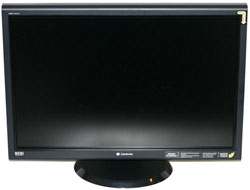 |
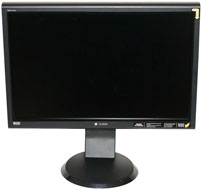 |
| Click to enlarge | |
The base stand provides five inches of vertical travel, which gives you a reasonable amount of height adjustment. The stand also allows you to rotate the LCD and use it in portrait mode. While we can't say using a 24" LCD in portrait mode is something we found to be particularly useful, some people might feel otherwise. One of the great things about having such a large LCD is that it gives you the ability to view two documents (or document pages, web pages, etc.) side-by-side with room to spare, making portrait mode largely unnecessary.
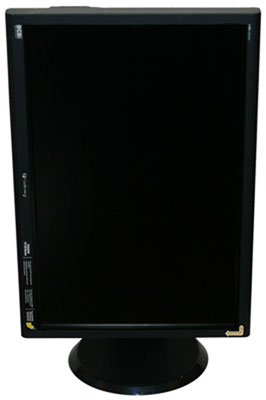 |
| Click to enlarge |
With the display in portrait mode, you don't get quite as much vertical travel, and cable routing can be a bit trickier as well. The display supports auto rotate functionality, so as soon as you rotate the display Windows will automatically recognize the new orientation and change your resolution as appropriate. It is unlikely that this functionality works outside of Windows, due to a lack of native drivers for other operating systems, but we did not actually test this functionality outside of Windows; regardless, as stated already we don't find portrait mode to be particularly necessary on widescreen displays.
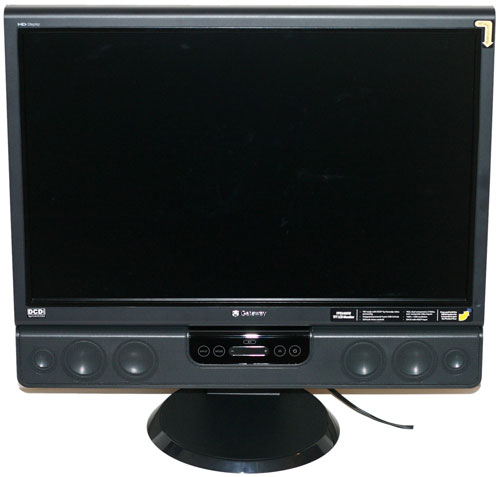 |
| Click to enlarge |
Here you can see a shot of the display with the optional speaker bar installed. The speaker bar attaches to the bottom of the LCD and receives power via a short cable that connects to the rear of the main display. The speakers only support stereo audio inputs (standard 1/8" DIN or RCA jacks), but they can try to emulate 3D surround sound if you'd like and the overall quality is pretty good given their size. There are plenty of better sounding speaker options available for $70 or less, but one nice benefit of the attached speaker bar is that you get reasonable quality audio without taking up much desk space. If you're more concerned with eliminating cable clutter than with getting premium quality audio, we would definitely add the speaker bar to a purchase of this display. The speakers also have the potential disadvantage of making portrait mode more difficult to access, so if you do intend to use the portrait mode we would forgo purchasing the speaker attachment.
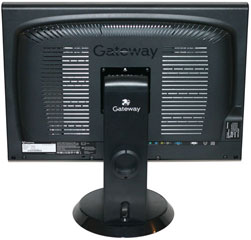 |
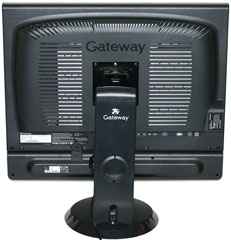 |
| Click to enlarge | |
Here you can see the rear of the unit, with or without the speaker bar. The back of the base stand also includes a small ring that can be used to aid in cable routing. If you would rather do without the base stand, you can of course remove the mounting bracket and use a standard VESA wall mount instead.
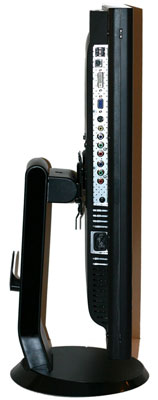 |
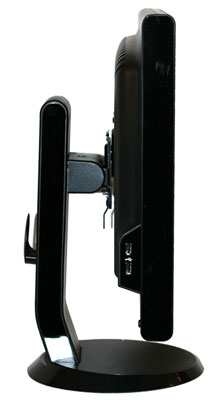 |
| Click to enlarge | |
All of the input ports are located on the back of the unit, facing downward. One of the advantages of being able to rotate the display is that it makes it easier to install the cables initially. The only ports not located on the bottom of the display are two additional USB ports which are located on the left side. The ability to have the display function as a USB hub can be useful, although personally we prefer the integrated flash memory readers found on competing Dell LCDs. Flash memory readers are cheap, but integrating them into the display is one more way of eliminating cable clutter. If you have a flash reader integrated into your PC, of course, having a second reader on your display is largely superfluous.










77 Comments
View All Comments
strikeback03 - Friday, February 23, 2007 - link
You skipped quoting the rest of the paragraph:Optimal brightness setting for LCDs is often stated to be 120 cd/m^2. So in many circumstances the extra brightness of the Gateway isn't useful.
JarredWalton - Friday, February 23, 2007 - link
400 cd/m2 is the most I could imagine using, and once both LCDs were adjusted the actual white point was a lot closer - meaning even though the maximum on the Gateway was twice as high, once calibrated I didn't use anywhere near that white level. 300+ cd/m2 can be almost painful to look at in my opinion, and 400 or higher is generally overkill.The point is, the only reason Gateway and others seem to have such insane brightness levels is to get better contrast scores. Most people will run around 200 cd/m2, give or take probably 50. But if your black is only able to reach a minimum of 0.35 cd/m2, that means the contrast ratio would be somewhere between 500:1 and 600:1. The "solution" is to simply crank up the maximum brightness, so you can claim a 1000:1 (or even 1200:1) contrast ratio. More is better, right? Except, it's not, because hardly anyone will actually use those super-bright whites.
Also worth noting is that if you max out brightness and contrast (max white level), the color accuracy scores go to hell and the whites all run together, so everything from about 200 or higher on the RGB scale ends up as the same level of white. At maximum contrast, the recommended calibrated brightness (according to Monaco Optix) is 20%, where if I choose 60 contrast the recommended brightness is 61%. As mentioned in the review, the overall color accuracy was better with contrast set to 60 as opposed to 100.
The maximum brightness (100% contrast) was even higher than reported: 500 cd/m2 was pretty close, but black went up to 0.45 cd/m2. Depending on the room you work in, higher brightness may be okay or not. I prefer running closer to 200-300 personally.
DigitalFreak - Friday, February 23, 2007 - link
All I can say is that I love my 2405!Painman - Friday, February 23, 2007 - link
Besides the already requested input lag tests, modern LCD reviews usually include at least a few gaming tests... some commentary on what kind of visual artifacts are evident with fast moving objects. I had 3 of these Gateways (returned for various defects) and tried to like it, but aside from other problems the smearing was just too much to take... green and brown smudges always popping up in my face. I bought myself an IPS based NEC and I ain't looking back.This isn't a very good gamer panel... thinking about it now sitting in front of this NEC, I can't really say the Gateway FPD2485W is a good ANYTHING panel, tbh.
Aquila76 - Friday, February 23, 2007 - link
If you want to see something that'll blow your mind on this display, fire up HL2. At the menu screen, where it's out of focus as it loads the game, it looks like you've dropped to 256 Color mode and are 'dithering' the image. I noticed the same effect when hitting the Nitro in a couple Need for Speed games.knirfie - Friday, February 23, 2007 - link
This monitor features DCDi by Farudja, why is there no mention of this in the review (or did I miss it?). And how is the videoquality/deinterlacing over composite/svideo/component?DigitalFreak - Friday, February 23, 2007 - link
Page 3:Souka - Friday, February 23, 2007 - link
get an apple cinema display and make sure its calibrated properly....nothing better IMHO... use them all the time at work. Some folk have those Dell units...yuk....color is off, things seem dull, despite all calibration attempts.
Good thing they're just doing web page design and programming....
dcr - Thursday, February 22, 2007 - link
Could you test WoW and see if you get this "flashing" in the terrain?chizow - Thursday, February 22, 2007 - link
Jarred, nice review of the 2485W, was wondering if you wouldn't mind posting your settings after you calibrated your display with Optix. Reason I ask is that myself and many others felt the color accuracy out of the box on this panel were horrible, especially compared to other displays. I was able to get better results by asking what settings people were using, and obviously what looks good to them will vary person to person and card to card, but it was a big help.Also, it might be worth noting what month your panel was made. There were some serious issues with this panel in early production runs (November), but each successive month seems to correct problems and greatly reduce other problems. Backlight bleed seems to greatly diminish as well as an annoying PSU buzzing problem with newer models.
Lastly, I was glad you mentioned the 1:1 pixel mapping, but I think there needs to be greater emphasis on this aspect of 24" panels or any panel able to do 1920x1080. In the era of HD with all of the inputs this monitor and some competitor models provide (BenQ, Dell Rev. A04), the ability to do 1:1 is a major consideration for the enthusiast. If you have multiple HD capable devices (HDTV, PS3, Xbox360, HD-DVD, Blu-Ray) this monitor can basically serve as your entertainment center, all while maintaining its main functionality as a massive 2.3 Megapixel PC display. There's really few other tech-enabling devices I've purchases that can compete with this panel's versatility and functionality.